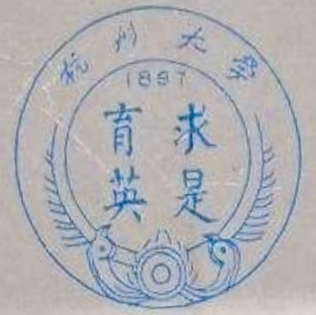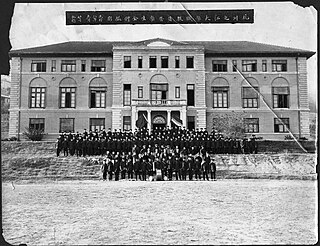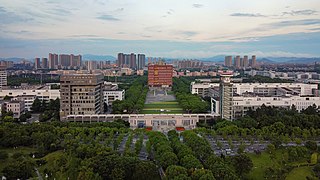
Zhejiang University is a national public research university in Hangzhou, Zhejiang, China. It is a member of the C9 League, Double First Class University Plan, Project 985, and Project 211.

Hangzhou University, colloquially called Hangda and formerly romanised as Hangchow University, was a public university in Hangzhou, Zhejiang, China. The university was founded as Zhejiang Teachers College in 1952 by merging the departments of humanities, sciences and education at Hangchow University and Zhejiang University. The name of the university in postal romanisation is the same as Hangchow University run by American missionaries, yet the Chinese names are different.
Zhejiang Medical University was a former university in Hangzhou, Zhejiang Province, China. In 1998, was merged into Zhejiang University to become its Medical School.

The Second Affiliated Hospital of Zhejiang University School of Medicine, known as Kwang Chi Hospital before 1952, is a non-for-profit tertiary care public hospital in Hangzhou, Zhejiang, China. Founded as a drug rehabilitation clinic in 1869 by the British Church Missionary Society, it is one of the oldest hospitals in Zhejiang to offer Western medicine and one of the leading medical centres in China.

Hangchow University, also spelled as Zhijiang University and formerly known as Hangchow Christian College, Hangchow College, and Hangchow Presbyterian College, is a defunct Protestant missionary university in China, which is one of the predecessors of Zhejiang University. Founded as Ningpo Boy’s Boarding School by Divie Bethune McCartee and colleagues of Northern Presbyterian Church in Ningbo in 1845, the university was one of the oldest missionary schools in China before it was shut down in 1952. The university was merged into Zhejiang University and other universities in China. Its campus was taken over by Zhejiang University as its Zhijiang Campus in 1961, which became a major nationally protected historic site in 2006.

Zhijiang Campus is an urban campus of Zhejiang University located in Hangzhou, Zhejiang, China. Located on riverside of the Qiantang River and close to the Liuhe Pagoda, it was the oldest university campus in Hangzhou. Built as the campus of Hangchow University, one of the oldest Christian colleges and universities in China, most of its buildings are protected as the Hangchow University Historic Site under the list of Major Sites Protected at the National Level. The campus is now home to James D. Watson Institute of Genome Sciences, Guanghua Law School and the Institute for Advanced Study in Humanities and Social Sciences.

Ningbo Campus is a campus of Zhejiang University located in the Ningbo Higher Education Park, Ningbo, Zhejiang Province.
NingboTech University, formerly known as Ningbo Institute of Technology, Zhejiang University, is a public university which transformed from an independent technical college formerly affiliated to the Zhejiang University in 2019. It is located in the Ningbo Higher Education District (寧波高等教育園區/宁波高等教育园区), Ningbo City, Zhejiang Province, People's Republic of China. It shares the Ningbo Campus with Zhejiang University. It was founded in June 2001, and mainly focuses on undergraduate education following the course of Zhejiang University.
The Y. C. Tang Disciplinary Development Fund is an educational foundation of Zhejiang University (ZJU).

The former site of Qiushi Academy is historic site protected as a Major Historical and Cultural Site Protected at the National Level. The site was made a college campus by Hangzhou mayor Lin Qi in 1897 and became the oldest campus of Zhejiang University and hosted the university until it moved to Yuquan campus in 1956.
Zhejiang Provincial College of Medicine, was a medical college for higher education in Hangzhou, Zhejiang Province, China. It was one of main roots for the current School of Medicine, Zhejiang University (浙江大學醫學院/浙江大学医学院).
The Technology Transfer Center of Zhejiang University, currently is the largest university technology transfer center in the People's Republic of China. It's the main technology transfer department of the Zhejiang University in Hangzhou, Zhejiang Province.
Zhejiang Ocean University is a comprehensive public university based in Zhoushan city, Zhejiang province, China.

Zhejiang University Library is the libraries system of Zhejiang University, and one of the largest and oldest university libraries in China.

Zhejiang University School of Medicine, formerly known as Zhejiang Medical University, Zhejiang Provincial College of Medicine, Zhejiang Medical School, locates in Hangzhou, Zhejiang Province, People's Republic of China. It's one of the oldest medical schools in China. In 2018, Zhejiang University was ranked 3rd overall in China.
Mokpo National University is located in Muan and Mokpo, South Korea. Mokpo, located in the most southwestern region of Korea, is a key coastal city of the Korean Peninsula. The main campus is located in the valley of Seungdal Mountain, which has a beautiful view of the sea and the surrounding area.

Hangzhou Normal University, or Hangzhou Teachers College, is a public university in Hangzhou, the capital of Zhejiang Province, China.

Zhejiang University-University of Edinburgh Institute, also known as Zhejiang-Edinburgh Institute and ZJU-UoE Institute, is an international joint academic and research institution based in Haining, Zhejiang Province, China. Founded in 2014, The Zhejiang University-University of Edinburgh Institute (ZJE) is a collaboration in the field of Biomedical Sciences between Zhejiang University, China and The University of Edinburgh, United Kingdom. Students are awarded with a University of Edinburgh degree as well as a degree from Zhejiang University. All programmes are taught in English and form part of the University of Edinburgh Medical School offering.

The International Campus, Zhejiang University, located in Haining, Zhejiang, China, is a Zhejiang University (ZJU) campus that came into use in 2016 as a base for international cooperation, including two joint institutes with the University of Edinburgh and the University of Illinois at Urbana-Champaign and a joint lab with Imperial College London. It is also home to Zhejiang University International Business School founded on the campus in November 2018. During the COVID-19 pandemic, it also hosts exchange students of several US universities including Cornell University.












